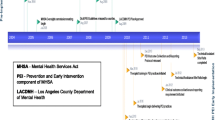Abstract
The recent debates about health care reform have focused attention on the need to develop organized systems of care capable of delivering comprehensive services which are coordinated or integrated. Achieving service integration has emerged as a central and pressing objective in most mental health systems in response to existing difficulties with fragmentation of care. However, attempts at service integration often fail at the implementation stage as provider agencies zealously guard their organizational boundaries and struggle with each other for power and control. In this article, the authors formulate an organizational development approach to service integration that focuses on reducing the rigid maintenance of agency boundaries by developing informal networks among staff of local provider agencies. Eight strategies, drawn from the research literature on services integration and recently implemented by a local mental health authority, are described as potential tools for use by systems managers in accomplishing these goals.
Similar content being viewed by others
REFERENCES
Adams S (1976). The structure and dynamics of behavior in organizational boundary roles, in Handbook of Industrial and Organizational Psychology. Edited by Dunnette, MD. Chicago, Rand McNally.
Aldrich H (1971). Organizational boundaries and inter-organizational conflict. Human Relations, 24, 279-293.
Aldrich H (1976). Resource dependence and inter-organizational relations. Administration & Society, 7, 419-451.
Aldrich H & Herker D (1977). Boundary spanning roles and organization structure. The Academy of Management Review, 2, 217-230.
Bond MA & Keys CB (1993). Empowerment, diversity, and collaboration: promoting synergy on community boards. American Journal of Community Psychology, 21, 37-57.
Gray B (1985). Conditions facilitating inter-organizational collaboration. Human Relations, 38, 911-936.
Greenley JR (1992). Neglected organization and management issues in mental health systems development. Community Mental Health Journal, 28, 371-384.
Hollander EP & Offermann LR (1990). Power and leadership in organizations. American Psychologist, 45, 179-189.
Kanter RM (1985). The Change Masters. New York, Simon & Schuster, Inc.
Levine M (1979). Case management: lessons from earlier efforts. Evaluation and Program Planning, 2, 235-243.
Levine M & Levine A (1970). A Social History of Helping Services. New York, Appleton Century Crofts.
Lipsky M (1980). Street-Level Bureaucracy: Dilemmas of the Individual in Public Services. New York, Russell Sage Foundation.
Mechanic D (1991). Strategies for integrating public mental health services. Hospital and Community Psychiatry, 42, 797-801.
Miles RH (1980). Organization boundary roles, in Current Concerns in Occupational Stress. Edited by Cooper CL, Payne R. New York, John Wiley & Sons.
Morrissey JP, Calloway M, Bartko WT, Ridgely MS, Goldman HH, & Paulson RI (in Press). Local mental health authorities and service system change: evidence from the Robert Wood Johnson Foundation Program on Chronic Mental Illness. The Milbank Quarterly.
Powell WW & Smith-Doerr L (1994). Networks and economic life, in The Handbook of Economic Sociology. Edited by Smelser NJ, Swedberg R. Princeton, Princeton University Press.
Sashkin M (1984). Participative management is an ethical imperative. Organizational Dynamics, 12, 5-22.
Shore MF & Cohen MD (1990). The Robert Wood Johnson Foundation program on chronic mental illness: an overview. Hospital and Community Psychiatry, 41, 1212-1216.
Van de Ven AH & Walker G (1984). The dynamics of inter-organizational coordination. Administrative Science Quarterly, 29, 598-621.
Van de Ven AH, Walker G, & Liston J (1979). Coordination patterns within an inter-organizational network. Human Relations, 32, 19-36.
Vroom VH & Jago AG (1988). The New Leadership: Managing Participation in Organizations. Englewood Cliffs, NJ, Prentice Hall.
Vroom VH & Yetton PW (1973). Leadership and Decision-Making. Pittsburgh, University of Pittsburgh Press.
Wagner JA & Gooding RZ (1987). Shared influence and organizational behavior: a meta-analysis of situational variables expected to moderate participation-outcome relationships. Academy of Management Journal, 30, 524-541.
Weiss JA (1981). Substance versus symbol in administrative reform: the case of human services coordination. Policy Analysis, 7, 21-45.
Author information
Authors and Affiliations
Rights and permissions
About this article
Cite this article
Hoge, M.A., Howenstine, R.A. Organizational Development Strategies for Integrating Mental Health Services. Community Ment Health J 33, 175–187 (1997). https://doi.org/10.1023/A:1025044225835
Issue Date:
DOI: https://doi.org/10.1023/A:1025044225835




